Forest Stories
By Chris Hewitson
In Forest Stories I consider historic deforestation and today’s reforestation of the Corbières forest in southern France. Through my reading, photography and field research, I have come to understand the forest as a diverse ecosystem supporting trees, plants, and non-human animals. As a result I now appreciate the ancient and ongoing relationship between the forest and its human neighbours.
This area was a part of the first province of the Roman empire outside Italy. The Via Domitia crosses the Corbières in its passage from the Alps to the Pyrenees, with stretches still to be seen in the forest today. For when the Romans left, the forest remained intact.
From the Middle Ages to the 19th century, people used the forest as the source for their material needs. By 1830, there was very little forest left and it is only in this century that the forest has begun to return.
My intent for this project is that it should promote the forest’s rich history and its fascinating present as a re-emerging ecosystem.
The project also glimpses the future forest as a repository for biodiversity and as a ‘sink’ for CO2 in a future dominated by the climate emergency.
Deforestation
I live in the village of Coustouge set in the Corbières Massif in the department of the Aude in southern France. When I first visited Coustouge in the mid-1970s, I felt as if I had travelled back in time to the 3rd French République of the early 1900s.
That period may have been the Belle Époch in Paris, but southern villages had only recently begun moving away from a subsistence economy. At that time, Coustouge had a population of about 250 people for the majority of whom life was tough.
Many households had small kitchen gardens alongside the river where they grew vegetables. If they had room, households had a pig or two. Usually a boar for fattening and killing in the Autumn to turn into preserves for the Winter months, and a sow for breeding next year’s boar plus piglets to sell for cash. Elderly villagers in the 1970s told me
The Corbières Forest
that there were always chickens wandering around the village when they were children, so presumably eggs would have been a source of protein with a boiling fowl - an old chicken that no was no longer laying eggs - as the base of an ocasional stew.
Other than that, people used the natural resources around them to sustain themselves. They picked wild plants to use as vegetables and in different seasons, picked wild-growing fruit, often to preserve for use during the cold months. During the Winter, food supplies would have been supplemented by what the hunters managed to catch - usually wild boar, but also small game such as rabbit or hare.
I cannot imagine that the small river passing through the village, La Robine, contained much that was edible although no doubt hungry people would take from it what they could such as frogs and bony fish.
Only now, while working on this project, ‘Forest Stories’, do I realise that people in 1900 did not have recourse to the forest. Their grandparents would have known a little of the forest, perhaps, but by 1850 it was all but gone.
From the beginning of the 18th century, sheep rearing had been an important economic factor in the life of the Corbières, reaching such proportions that official figuresshow that by 1830 there were 615, 000 sheep in the region. That’s a lot of land occupied by beasts that spend most of the day eating.
The last of the hillside forest was cut down to make way for pasture land for the sheep. To provide shelter for these animals, and with the forest gone, stone shelters known as granges were built which the sheep entered every night. Not all granges were out
on the deforested hills, some were built in villages such as in the case of my own house, where the grange was built as an annexe. The positioning of these granges and their nightly use as shelters for sheep, indicates that people were constantly crisscrossing the landscape to let sheep out onto the hillsides in the morning, tending the sheep during the day, fastening them into the granges at night, and taking the sheep to market or for slaughter.
This means that for the best part of 200 years, the hillsides would have been almost constantly filled with activity which by the early 20th century had virtually ceased although a few stragglers remained. According to one village resident, the last sheep in Coustouge were sent to market in 1937 but the sheep economy had come to an end long before then as the vine had had taken over as the new monoculture.
Geography, Climate and History
The Corbières Massif is mostly situated in the département of the Aude, extending a little into the Pyrenées Orientales. The massif is bounded to north and west by the river Aude, by the Mediterranean to the east and the Fenouillèdes region to the south.
The principal towns of the Corbières are Carcassonne (the Préfecture of the Aude), Narbonne (Sous-Préfecture) Tuchan and Rivesaltes. The Corbières mountains appeared about 65 million years ago at the start of the Cenozoic, the geological era that saw the ascendancy of mammals, The mountains are formed mostly of limestone, which is is highly soluble in water, attaining heights of between 400 and 500 metres. Erosion over millenia by wind, rain and rivers has created wide valleys and deep gorges and frequently softened the aspect of once-rugged mountain peaks. Today the landscape is noted for its typically Mediterranean flora formed into ‘garrigues’ (scrubland) pine forests and an undergrowth of holm oak. Today’s distribution of flora has
been brought about by human activities particularly as noted above, animal husbandry and viticulture. Even today’s ‘garrigue’ is not the scrubland of a thousand years ago. Clearing the garrigue to make way for sheep has destroyed the original ‘thick’ scrubland to make way for today’s ‘thin’ chaparral.
Climate
The Corbières climate is Mediterranean typified by high heat in the Summer traditionally with short periods of between 30C and 40C. although these high temperatures have become very common in recent years. There is generally little rain during the Summer months although there are occasional intense thunder storms. Autumn is the period of most rain. A number of rivers - such as the Aude, the Orbieu and the Agly - run through the region.
History
By the time of the Arab invasions (719 - 759)
the Corbières had already been fortified by the Visigoths. In 865, after the Moors had been vanquished, Charles the Bald, King of France, divided the former Roman and then Visigoth province with the southern region going to the Count of Barcelona, and northern section marked by the Corbières massif being given to the jurisdiciton of Narbonne.
To the south of the Corbières lies the region of Rousillon which in the Middle Ages became wealthy and in 1180 were attached to the crown of Aragon then to that of Spain thus making the Corbières a heavily defended border region, hence so many hill top fortifications.
The Cathars
All points of passage from north to south were controlled by a set of castles: Peyrepertuse, Quéribus, Puilaurens, Aguilar, Termes, etc.. The Languedoc (the larger region of which the Corbières is a part), at first under the suzerainty of the
kingdom of Aragon, came under the control of the kings of France during the Albigensian crusade. The Albigensians, or ‘Cathars’ formed a Christian gnostic movement between the 12th adn 14th centuries. They are mainly remembered today because of their persecution by the Catholic church.
The Renaissance
With the proliferation of firearms and canon across the defenses of the Corbières, it was very difficult for any army to invade from the south unless they took the route of the mosquito-infested lagoons at the coast.
Ulitmately, in 1659, the Traty of the Pyrenées put an end to the military history of the Corbières.
Forests are important for People
Forests cover around one third of all land on Earth - it used to be a lot more - and breathe life into our world but it is not just the planet that suffers when they are destroyed. As we have seen in the Corbières, forests are important for people’s lives, homes and livelihoods. They have a crucial role to play in tackling the biodiversity and climate crises. Forest products are a vital part of our daily lives from paper to wood products and by-products used in medicines, cosmetics and detergents.
Over 1.6 billion people depend on forests for food or fuel, and some 70 million people across the world call forests home. Forests provide us with oxygen, shelter, jobs, water, nourishment and fuel. With so many people dependent on forests, the fate of our forests may determine our own fate as well.
Forests help prevent erosion and enrich and conserve soil, helping to protect communities from landslides and floods and producing the rich topsoil needed to grow plants and crops. Forests also play an important role in the global water cycle, moving water across the earth by releasing
The World Wildlife Fund for Nature
Why Forests are important
water vapor and capturing rainfall. They also filter out pollution and chemicals, improving the quality of water available for human use. The destruction of forests has a knock-on effect on agriculture and can affect the production of the food we eat.
Human health is inextricably linked to forest health. Deforestation has serious consequences on the health of people directly dependent on forests, as well as those living in cities and towns, as it increases the risk of diseases crossing over from animals to humans. Meanwhile, time spent in forests has been shown to have a positive benefit on conditions including cardiovascular disease, respiratory concerns, diabetes and mental health.
Forests matter for nature
Forests are home to over 80% of terrestrial biodiversity, including 80% of amphibians, 75% of birds and 68% of mammals. Deforestation of some tropical forests could lead to the loss of as many as 100 species a day. Our ability to stop biodiversity loss is heavily dependent on our ability to
stop forest loss. When we take away the forest, it is not just the trees that go. The entire ecosystem begins to fall apart, with dire consequences for all of us. Forests provide habitats for plants and animals, including some of our planet’s most iconic species like the tiger, giant panda, gorilla and orangutan. Habitat loss is one of the main causes of biodiversity loss, as land that once was forest is cleared for other uses. Forestdwelling wildlife populations (which include mammals, birds, reptiles and amphibians) have declined on average by 69% since 1970, with tropical forests such as the Amazon the worst hit.
Forests and the climate
Forests are the largest storehouses of carbon after the oceans, as they absorb this greenhouse gas from the air and lock it away above and below ground. So, it is no surprise that when we cut down or damage our forests, we release huge amounts of carbon emissions that contribute to the climate crisis.But forests are also important as they
can help protect people and nature from the consequences of a warming world.
As the impacts of climate changeincluding floods and storms from rising sea levels and increased precipitationbecome more frequent and severe, forests can provide a crucial buffer for our communities. Extreme events caused by climate change, such as more frequent wildfires, limit the ability of our forests to regenerate. At the same time, deforestation contributes to climate change by increasing the risk of fires. Stopping deforestation and restoring forests is a crucial part of climate action.
Reproduced by kind permission of WWF
Further information at the WWF website: wwf.panda.org






















Boar leave the forest nightly, frequently entering the orchard. In June 2023, for the first time, a sow took her piglets (known as marcassin in French) with her. If you turn up the volume you will hear the grunts and squeaks of the weaners as they learn to select their food.
 The small fox pictured on the next page is a regular visitor. In early June 2023 it suddenly began appearing in the evening rather than during the night. In one section of the video you can hear a bird squawking loudlyperhaps to alert others to the presence of danger.
The fox
Boar with marcassin
The small fox pictured on the next page is a regular visitor. In early June 2023 it suddenly began appearing in the evening rather than during the night. In one section of the video you can hear a bird squawking loudlyperhaps to alert others to the presence of danger.
The fox
Boar with marcassin
A badger visted the orchard between January and March 2023 to forage. In this clip, listen out to hear the badger cracking on snail shells using its strong teeth, The badger is usually seen ambling unfussed, but at the end of this clip you will see it speed up when surprised by the sudden clanging of the church clock’s bell.
 Beech marten
Beech marten
The beech marten is the mainland European version of the pine marten. A pair of them regularly come from the forest and enter the orchard next door. The beech marten moves rapidly, using bouncing steps to propel itself forward. You can see these movements in this short video clip. I have observed that the beech marten goes to the orchard more frequently in Winter than at any other time of the year. I also note that the beech marten never enters the garden when other animals might be around; not even domestic cats.
Badger





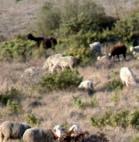
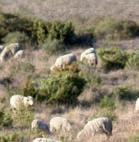


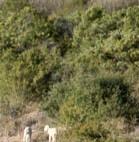
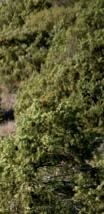
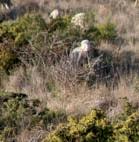


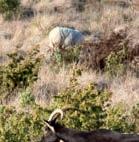


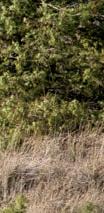
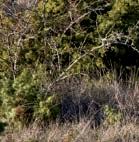
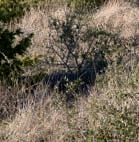
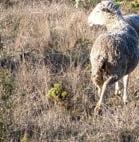
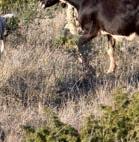
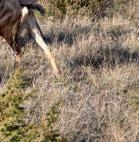
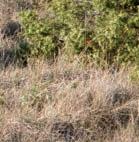
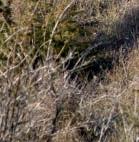

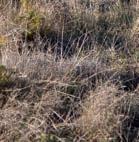

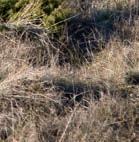
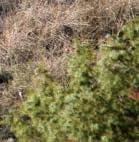
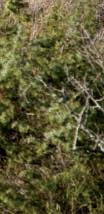












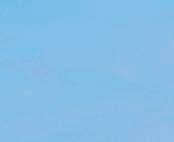



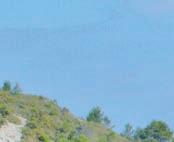

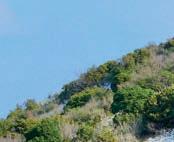
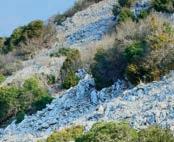

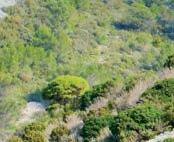
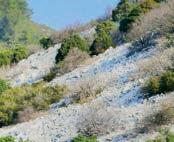





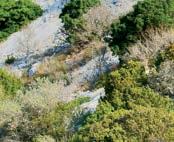
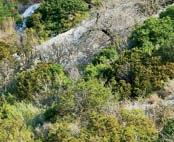

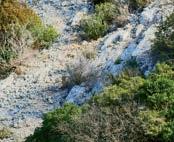




























The owl’s cry
In this recording from 14th June 2023, made at about 22h00, you hear an owl crying and the wind blowing hard. These are moments that make us remember the forest tales that frightened us as children. Stories of Hansel and Gretl, Snow White or Sleeping Beauty. While I was working on this project, planning for personal safety in the wild areas of the hills and forest was very important.
















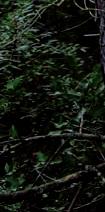
The nightingale
The sound of a nightingale singing in the forest in early Summer is one of Nature’s most perfect sounds.I recorded this bird at midnight on the 8th June 2023.













The above typology contains photographs of the first section of pine forest to return after the great deforestation. Unlike areas of forest which are self-regenerating, this earlier section was planted by children of the village of Coustouge during a series of planting sessions between about 1925 and 1928. The photographs were taken in May and June, 2023, from the top floor of my house in the village.
The video was made on 29th June 2023, and captures something of the strength of a Mediterranean storm. It shows the power of the wind and rainwater, indicating their abilithy to wash away the topsoil on the hillsides as happened in the 19th century once the trees had been cut down


























































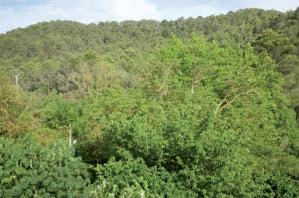 Restless Forest
Restless Forest
All
For their invaluable support and guidance during this project, I should like to thank the following people:
Wendy McMurdo
Jesse Alexander
Paul Clements
Laura Hynd
Karen Aneiro
Alan Conteh
Emma Hart
Peter Bushby
The team at Newspaper Club
WWF London
The estate of Ken Towner
Chris Hewitson contact details chrishewitson@me.com
+33 (0)6 03 71 94 96
postcards
photographs in this broadsheet are by Chris Hewitson apart from the three black and white
of Coustouge, which are said to have been made in 1908 by an unknown itinerant grocer; and the photograph of Chris Hewitson and Michael Poynor on the roof of their Coustouge house, which was taken in August 1978 by Ken Towner, photographer at the London Evening News (all permissions granted).
Legend






The ever-changing aspect of the forest is testimony to the range of ways in which humans describe their relationship with it. On a sunny morning it can be a delight to walk along woodland paths, alone with one’s thoughts. But at other times, the forest can appear dark and foreboding; at such times we may hesitate even to enter.
The forest provides plentiful cover for non-human animals, but as a forest of pines it does not provide much food for them, especially in time of drought as at present. Thus at night, animals such as this badger leave the forest to forage.

The presence of boar in the Corbières forest is mentioned in texts from the 8th century. Their numbers dropped after deforestatiion but their numbers have greatly increased in recent years. Drought appears to be impelling them to enter vines and gardens to look for foods containing more moisture than they find in the wild.




Foxes and beech martens often enter gardens while stoats, mink and other small animals prefer to keep well away from humans. The insect populations have much declined in recent years and this has caused bird and bat populations to decline.
This is a photograph of the Corbières forest looking north towards the National forest at Thézan and the Communal forest of Ferrals. These distinctions refer to the bodies responsible for care of the different forests. Prior to deforestation the forest consisted mostly of holm oak, while the regenerating forest is made up of pines.

From the Middle Ages until the early 19th century, people used the forest as their principal source of fuel for homes and industries as well as for food and building their houses. But for 200 years from about 1700, large flocks of sheep were introduced and the forests cut down to make way for pasture
By the 1830s, most of the forest had gone. There remaned very little to anchor the soil to the hillsides so that it was swept away during the annual succession of Mediterranean storms. Mountain springs and streams disappeared, so no longer fed rivers, and wildlife was devastated.

During the 19th century, the economy of the Languedoc, the region in which the Corbières is situated, changed from subsistence living of growing in small plots, hunting and foraging in the forest for one’s own food to one where the vine became important as a cash crop. Peoples’ material lives began to improve.




Some Corbières households grew wealthy after the mid-19th century when the Languedoc was asked to substantially increase its wine harvest. The phylloxera pest had hit the vineyards of Bordeaux and Burgundy and the government deemed it crucial to maintain the flow of wine to the dining tables of the big cities.
Thus, gradually, people first learned how to live without the forest and then to forget they ever needed it at all. In this photograph from 1908, taken by an itinerant grocer (also author of the two previous images). one can see that the hills around the village are completely denuded of trees.
The Corbières massif appeared 65 million years ago at the beginning of the Cenozoic geological era. It consists of limestone which can be used for building and is why so many fossils have been found in the region. Post deforestation, it took two centuries of weathering before small plants could get a foothold and kickstart the process of reforestation.

In the 19th century, it became common for cypress trees to be planted in Corbières churchyards. They are still there to this day. However, the seeds from these cypress trees have been dispersed in the wind so now may be found as part of the newly-forming forest.

To make way for the enormous exapansion of viticulture after 1870, the forest on the valley floors were cut down. In this photograph taken near Villesèque-des-Corbières, one can see the forest resuming on the hills, the valley still given over to vines, and cypress trees being used as wind breaks.
As the Roman empire grew, traders and the army needed to move around the various territories speedily. The Via Domitia connected Rome with its provinces in southern France and in Spain. In this photograph a section of this road can be seeing traversing the forest at Roquefortdes-Corbières.

In this photograph, the forest appears sombre and forbidding. While I was working on this project, there were days when I could hear the hunt nearby. So, I worked fairly quickly, hoping that the hunters would realise I was there, a man in bright clothing, so not a boar!
In some parts, pine forests grow very thick, and the soil cannot hold them. Frequently trees collapse creating micro-ecosystems for small mammals, birds, lizards and insects. Deadwood also creaties organic matter that supports diverse plant life in the forest.
This photograph shows the forest in its glory. Tall trees reaching high, pine cones full of seeds ready to fall, branches ready to fall to ‘feed’ the forest floor. And the sun shining through, touching everything it reaches in the forest.
The series of photographs of the forest seen from my house, I made between March and July 2023. These pictures show different moods of the forest at different times of the day and in different weather conditions






















































 This is a photograph taken in August 1978, by Ken Towner of the London Evening News. It is of Michael Poynor, and I taking a break from demolition work on the roof of our house in Coustouge. As can be seen, seventy years after the previous pictures, the hills remained bare as the forest had not yet begun to recover.
This is a photograph taken in August 1978, by Ken Towner of the London Evening News. It is of Michael Poynor, and I taking a break from demolition work on the roof of our house in Coustouge. As can be seen, seventy years after the previous pictures, the hills remained bare as the forest had not yet begun to recover.























 The small fox pictured on the next page is a regular visitor. In early June 2023 it suddenly began appearing in the evening rather than during the night. In one section of the video you can hear a bird squawking loudlyperhaps to alert others to the presence of danger.
The fox
Boar with marcassin
The small fox pictured on the next page is a regular visitor. In early June 2023 it suddenly began appearing in the evening rather than during the night. In one section of the video you can hear a bird squawking loudlyperhaps to alert others to the presence of danger.
The fox
Boar with marcassin
 Beech marten
Beech marten



































































































































 Restless Forest
Restless Forest













